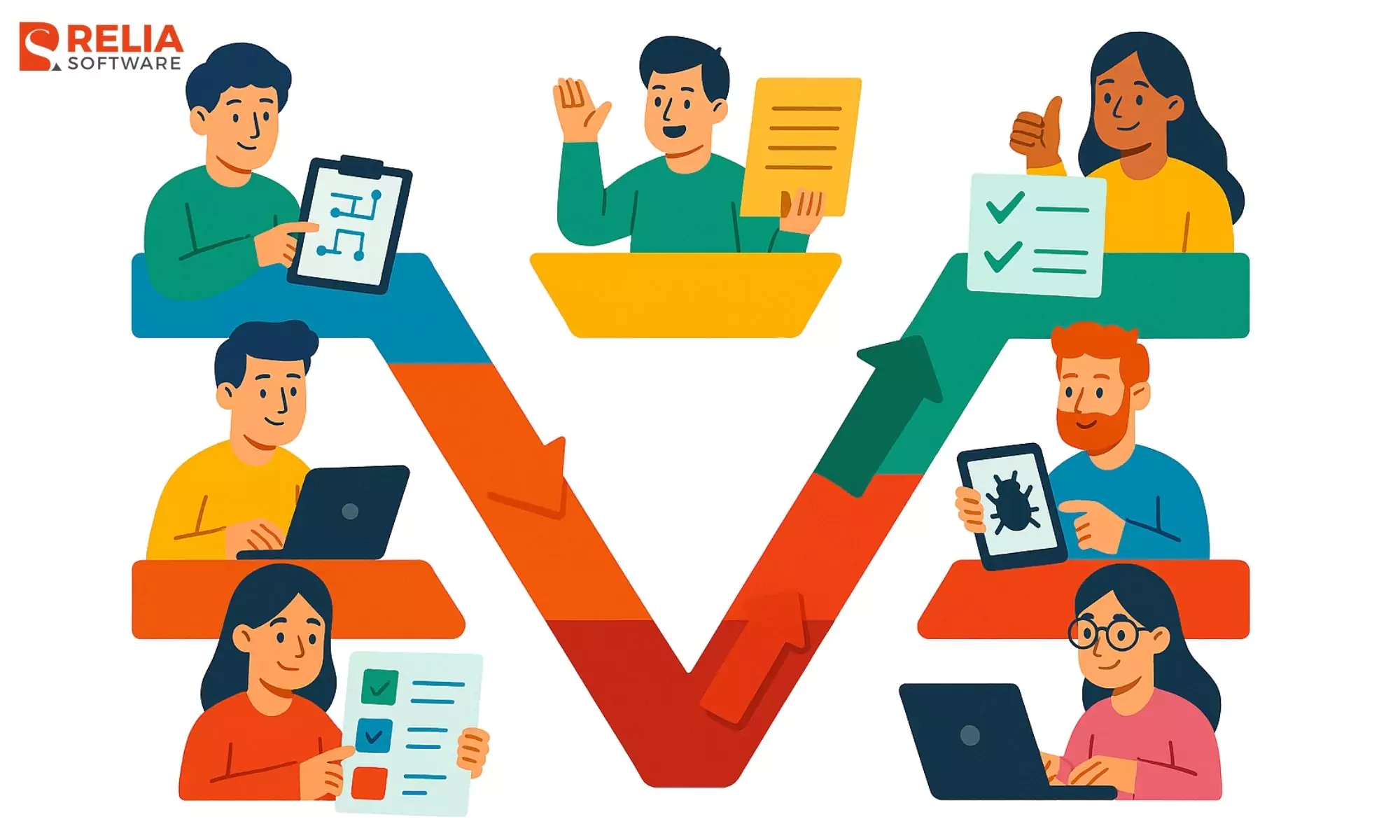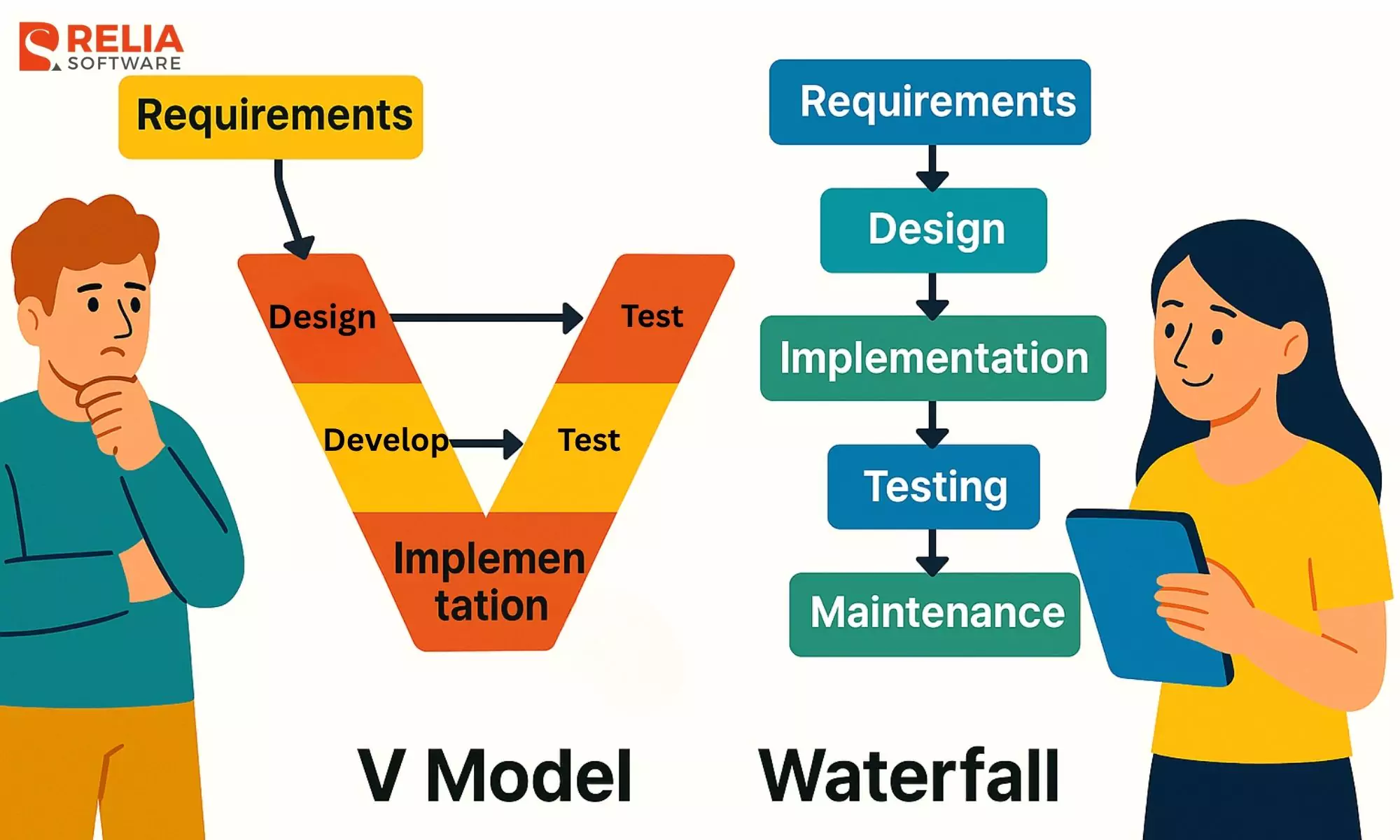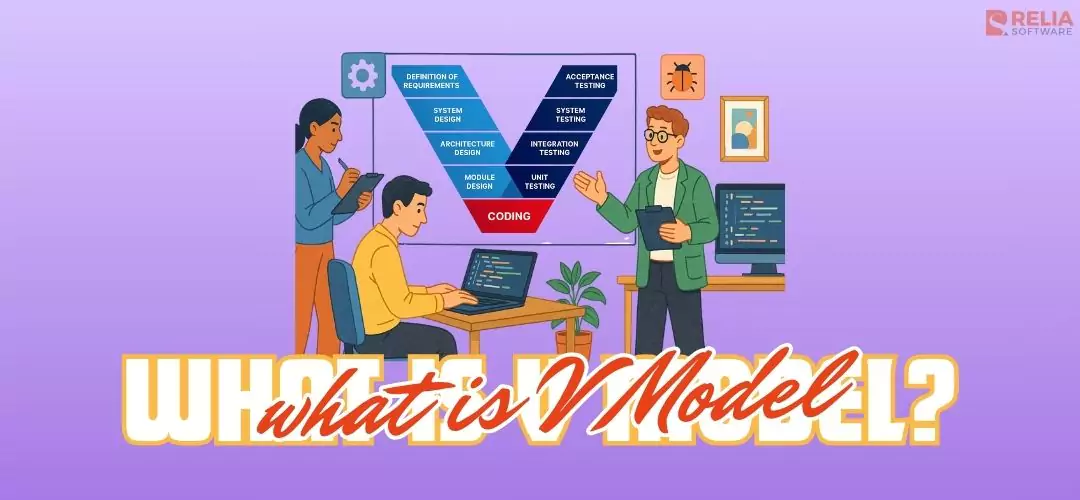Software engineering is rapidly expanding thanks to the availability of viable software development models. The V Model in software engineering is a prominent software development lifecycle model (SDLC) that involves sequential execution and parallel testing for each step of development.
This article discusses the definition and differences between the verification and validation phases of the V Model, its principles, pros and cons, and where this model is best and where it should be avoided. Let's check it out!
>> Read more: 8 Software Development Life Cycle (SDLC) Methodologies
What is the V Model?
The V Model, also known as the Verification and Validation Model, emphasizes early and frequent testing throughout the software development process. The process of the V Model is shaped like a "V." The steps on the left are for planning and making the software, and the steps on the right are for checking what was made.
This model divides the building process into steps, such as planning, writing code, and checking the work. Each stage has a matching test phase to discover errors early. This saves time and money while improving program quality. Particularly for projects with few modifications, the V Model also performs effectively with methods of continuous integration and deployment.

2 Phases of the V Model
The V Model establishes a clear path, with each stage in development having a specific testing equivalent. It has two main phases, which are verification and validation.
Verification Phases
The verification phase checks the product development process to ensure the team meets the criteria. It involves 5 steps that are:
- Business requirement analysis: Helps the team study what the customer wants and documents all the product requirements.
- System analysis: System engineers will review the customer’s needs and break them down into technical system requirements.
- Software architecture design: The team plans the overall structure of the software, including modules, how they connect, and which technologies to use. This also helps prepare for integration testing later.
- Module design: The software is divided into smaller parts (modules), and each part will be designed in detail.
- Coding: The development team chooses a programming language depending on design and product needs, using agreed coding standards and reviewing the code to make sure it performs well.
Validation Phases
The validation step uses dynamic analysis and testing to guarantee that the program satisfies customer needs. This phase includes:
- Comprising unit: The team creates and runs unit test plans to find code or unit issues. Program modules are tested to make sure they work correctly by themselves.
- Integration: Integration testing verifies how different modules work together as a group.
- System testing: The entire software is tested as one system, following the plan created during the system design phase, to ensure all features work as expected.
- Acceptability testing: The software is tested in a real user environment to see if it works well with other systems and meets performance goals. This step helps ensure the product is ready for release.
>> Read more: What are 4 Levels Of Testing In Software Testing? With Examples
Principles of the V Model
The V Model emphasizes testing and quality assurance throughout the development process. Here are some of the V Model's core principles.
Integrate Testing Throughout Development
Testing is more than just a final step in the development process. Instead, testing is incorporated throughout the development process, from requirement gathering to deployment.
>> Read more:
- Software Testing Life Cycle (STLC)
- Detailed Explanation of 7 Software Testing Principles
- A Guide to Functional Testing for Ensuring Flawless Software
Plan Testing throughout Development
Each level of the development process has its testing phase. Testing efforts are planned concurrently with development activities to ensure that sufficient resources are available to support testing.
>> Read more:
- How to Write A Powerful Test Plan in Software Testing?
- An Ultimate Guide to Different Test Case Design Techniques
Prevent Defects
The V Model emphasizes the necessity of preventing problems rather than simply detecting and correcting them once they have been detected.
Develop Clear and Concise Requirements
The V Model places a strong emphasis on precise and concise needs. Without a clear grasp of what the product is supposed to perform, it is impossible to write effective tests or create high-quality code.
Combine Development and Testing
In the V Model, development and testing are not distinct processes. Instead, they are tightly interwoven, and collaboration between developers and testers is vital to ensure that the program fulfills the necessary quality requirements.
Pros and Cons of The V Model
Pros
- Better Software Quality: Since testing happens early and continues through every stage, bugs are found and fixed sooner. This helps avoid big problems later and leads to better-quality software.
- Fewer Defects: Every step in development has a matching test step. This makes sure no part is skipped, helping teams catch issues early, before they grow into bigger, more costly problems.
- Easier Project Management: The clear structure of the V Model makes it easier to plan the project. Managers can assign tasks, set timelines, and track progress more effectively. It also encourages better communication between developers, testers, and stakeholders.
- Good Documentation: The V Model requires detailed documentation at every stage, including system designs, requirements, and test cases. This helps everyone understand how the system works and makes future updates easier to handle.
Cons
- Less Flexibility: The V Model follows a strict, step-by-step process. If project requirements change during development, it’s hard to adjust without going back and redoing earlier steps.
- Longer Development Time: Because the model includes a lot of testing, it can take more time, especially for big projects. It’s great for quality, but not ideal when speed is the top priority.
- More Resources Needed: The V Model requires a dedicated testing team and more effort throughout the development cycle. For smaller projects or teams with limited resources, this might be too heavy.

When to Use the V Model?
The structured approach and focus on thorough testing of the V Model make it a useful method for certain kinds of projects. When the V Model shines, these things happen:
Clear Requirements
Stability is very important for the V Model. If the needs of the project are clear and won't change much during the creation process, the V Model works very well. Its clear steps and organized testing make sure that all of the software's parts are checked carefully against the set requirements. This gives teams confidence that the final product will meet expectations.
High-Risk Projects
The V Model’s focus on early verification and validation is especially helpful for mission-critical projects, where failure can have serious consequences. Including testing at every stage of development, it helps catch and fix issues early, before they become bigger problems later on. This proactive approach improves reliability and ensures the software performs correctly, even in high-pressure or unexpected situations.
Projects with Regulatory Compliance Needs
In certain industries, software developers must follow strict rules and regulations. The V Model is helpful here because it emphasizes clear and detailed documentation at every step. Keeping records of requirements, system design, and testing helps prove that the project meets regulatory standards. This is especially useful during audits or certifications, as it can speed up the process and reduce the chance of compliance issues.
Comparisons Between V Model And Waterfall SDLC Model
The V Model and the Waterfall Model are both older SDLC methods that are known for their organized way of doing things. But there are some important differences between them that you should think about when picking the right method for your job. What they have in common and what makes them different are listed below.
Similarities:
- Sequential Technique: Both methods use a step-by-step, sequential technique. Each stage of development happens in a straight line before going on to the next one.
- Defined Planning: Both models promote planning and gathering requirements up front, which makes for a clear project roadmap.
- Focus on Documentation: During the whole creation process, both methods stress how important it is to keep detailed documentation.
Differences:
The differences between the V Model and the Waterfall Model can be illustrated below:
Features | V Model | |
Testing Emphasis | Early and continuous testing throughout the development lifecycle | Testing primarily occurs at the later stages |
Flexibility | Less flexible, struggles with evolving requirements | Even less flexible, significant changes require revisiting earlier phases |
Development Time | Can take longer due to comprehensive testing | Generally faster due to less focus on testing in early phases. |
Resource Intensity | Requires dedicated testing teams for thorough testing | Resource requirements may be lower |
Suitability | Ideal for projects with well-defined requirements and high-risk projects. | Best suited for projects with stable requirements and clear deadlines. |
>> Read more: Agile vs Waterfall Methodology: Which One is Better?

Best Practices for Implementing the V Model
The V Model provides a foundation, but it must be customized for your project to succeed. Consider these ideal practices:
Tailoring the V Model
While the V Model is strict in its steps, it can be adapted. If your project has changing requirements, allow some flexibility. For example, you might let teams make small updates to earlier phases without starting over completely. The key is to use the V Model as a guide, not a one-size-fits-all rule.
Effective Communication
The V Model relies on clear communication and collaboration between development, testing, and stakeholder teams. Regular communication ensures everyone understands project requirements, testing goals, and challenges. Developers must understand testing criteria, and testers must understand system functionality. Progress and difficulties must be communicated to stakeholders. Keeping everyone in the loop helps avoid misunderstandings and builds a stronger product.
Using Tools and Automation
Testing takes time and effort. To make things more efficient, consider using automation testing tools. These tools can handle routine checks, so your team can focus on more complex testing. Also, use version control systems to track changes and help prevent bugs from coming back in future updates. The right tools can make the whole V Model process smoother and more effective.
>> Read more:
- Agile Software Development: Values, Principles, & Phases
- In-depth Explanation Of Iterative and Incremental Development
- A Comprehensive Guide to Iterative Development For Developers
- What is DevOps? Principles, Life Cycle, and Best Practices
Conclusion
In conclusion, the V Model allows for simultaneous verification and validation at any level. It is ideal for projects with definite and predefined criteria. However, it is not appropriate for complex, large-scale projects with uncertain requirements. Therefore, when choosing the right model for your project, remember to consider the project's criticality, the technology used, tools and techniques, etc.
>>> Follow and Contact Relia Software for more information!
- development

